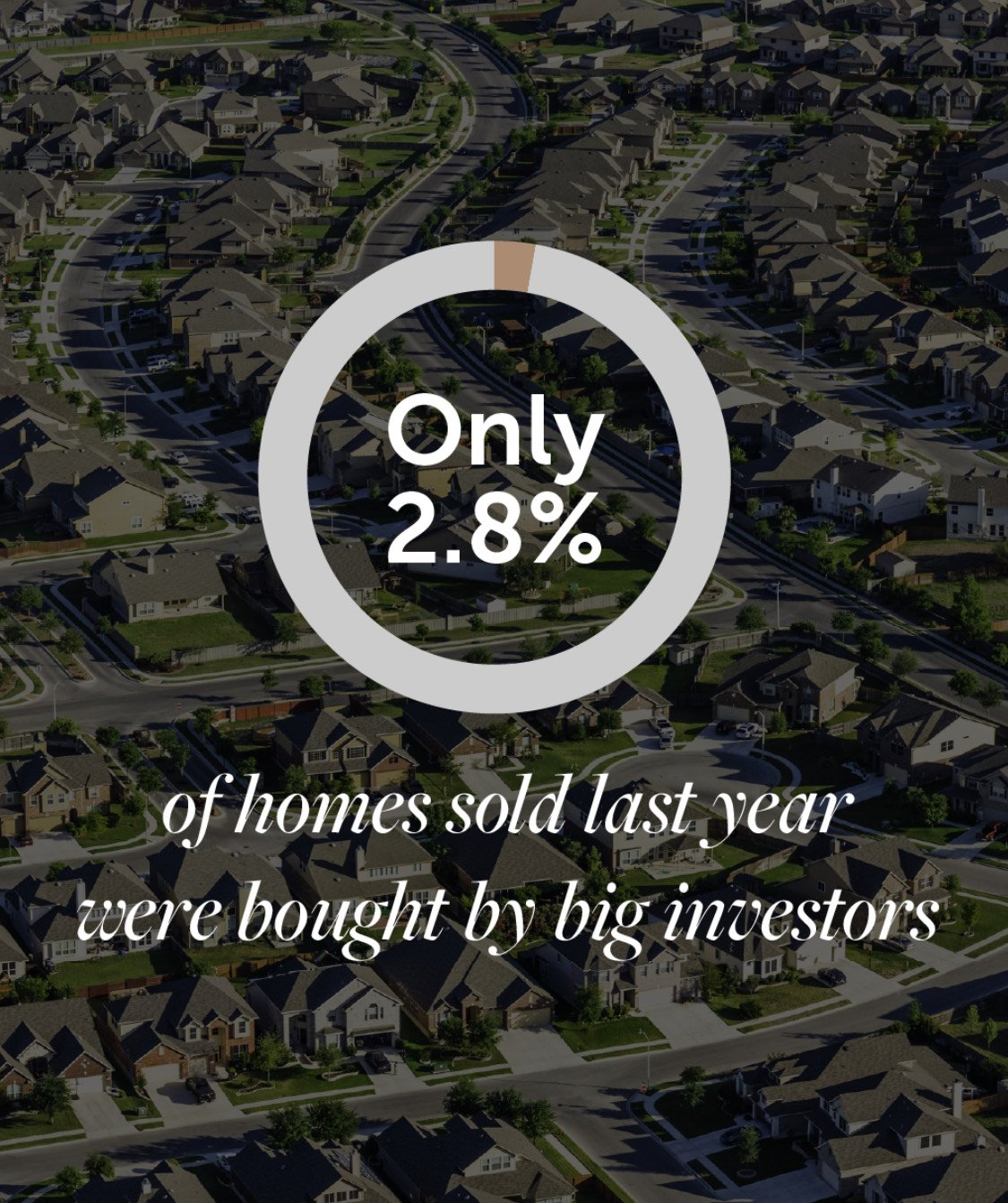If you spend any amount of time scrolling through real estate conversations online, you’ve probably seen a common belief: “Investors are buying everything and driving prices up.”
It’s a popular idea, but here’s the truth.
The data tells a completely different story.
Last year, only 2.8 percent of homes nationwide were purchased by large investors.
That means more than 97 percent of sales were regular buyers — families, first-time buyers, move-up buyers, and everyday people who needed a place to live.
So if investors aren’t the ones pushing home prices higher, what is?
The real cause is something far less flashy and far more important: a long-term housing shortage. For years, the number of people who want to buy a home has far exceeded the number of homes available. And supply and demand always win.
Today, that dynamic is finally starting to shift. More homes are hitting the market, easing some of the upward pressure on prices in many areas — including right here in East County San Diego.
This guide breaks down what is really happening, why prices rose so quickly, and what increasing inventory means for buyers and sellers in Jamul, Rancho San Diego, La Mesa, Alpine, and the surrounding communities.
The Investor Myth: Why So Many Believe It
The idea that investors are buying everything has spread quickly online. It’s simple, easy to understand, and fits into larger fears about affordability. But while investors do play a role in certain markets, they are not the main force shaping home prices — and they never have been.
Here’s why the investor myth feels believable to so many:
• People remember news stories about Wall Street buying homes in 2020 and 2021
• Social media amplify sensational claims
• New construction lagged for years, so buyers felt squeezed
• Prices rose fast, so people looked for someone to blame
• Some local pockets did see investor activity, but they were the exception, not the rule
When buyers compete for limited homes, it’s easy to assume someone powerful is pushing them out. But the numbers show otherwise.
The Real Data: Only 2.8 Percent of Homes Were Purchased by Large Investors
This statistic is important.
Not 20 percent.
Not 40 percent.
Not half the market.
Just 2.8 percent.
That means:
• The overwhelming majority of purchases were made by everyday homebuyers
• Most competition in the market was buyer vs buyer — not buyer vs corporation
• Investors are not the reason prices surged
• Local market conditions matter far more than Wall Street activity
Large investors simply do not influence the East County San Diego market the way social media suggests.
So What Actually Pushed Prices Higher?
One thing.
Something simple.
Something predictable.
A long-term housing shortage.
For more than a decade, the United States has not built enough homes. Meanwhile, population growth continued, family formation expanded, remote work increased, and demand for homeownership surged.
In East County San Diego, this supply problem has been even more pronounced.
Here’s why:
• Limited buildable land in communities like Jamul and Alpine
• Strong school districts in Rancho San Diego
• High demand for walkability in La Mesa
• Older, established neighborhoods with little room for new construction
• Strict zoning and slow building approvals
• Years of underbuilding after the 2008 recession
When supply stays low and demand stays strong, prices go up. Not because of investors. Because of basic economics.
The Housing Shortage Created the “Pressure Cooker” Market
From 2020 to 2023, the shortage became visible for the first time. With record-low interest rates and more people wanting space, homes across East County received multiple offers within days.
Prices didn’t rise because investors were buying everything.
Prices rose because everyone was trying to buy — and too few homes were available.
Bidding wars happened because:
• There were 10 buyers for every 1 home
• Interest rates made monthly payments more affordable
• Remote workers sought more space
• Millennials were entering peak homebuying age
• Move-up buyers needed more room
When a market becomes an intense seller’s market, prices naturally climb. Investors were not the fuel. Demand was.
The Good News: More Homes Are Hitting the Market Now
After years of extremely low inventory, we are finally seeing more listings in many parts of the country. And that includes East County San Diego.
More homes for sale means:
• Buyers have more choices
• Competition softens
• Price pressure eases
• Negotiation becomes more balanced
• Homes take slightly longer to sell
• Inventory levels inch closer to normal
This is not a market crash.
This is a market rebalancing.
A balanced market is healthier for everyone — buyers and sellers.
What Rising Inventory Means for East County San Diego Buyers
If you’re thinking about buying in Jamul, Rancho San Diego, La Mesa, Alpine, or the surrounding areas, this shift gives you real opportunities.
1. More options to choose from
You’re no longer forced to pick the one home that hit the market this week.
2. Less pressure to rush
When buyers slow down, you can make decisions more confidently.
3. Better negotiating power
Sellers are more open to credits, repairs, and flexible terms.
4. A better chance at finding your ideal layout
Whether you need land in Jamul, a single story in Rancho San Diego, walkability in La Mesa, or peace and privacy in Alpine, inventory matters.
5. Fewer bidding wars
More supply cools competition naturally.
This does not mean homes are cheap or that prices will drop dramatically. It means the market is becoming more reasonable — and that benefits buyers.
What Rising Inventory Means for Sellers
If you’re planning to sell, rising inventory means you must be strategic. Homes still sell well when they’re:
• Priced correctly
• Presented beautifully
• Marketed professionally
• Guided by an expert listing agent
But the days of “list it at any price and watch it fly off the market” are gone.
Sellers in East County can still achieve strong prices, but preparation and pricing matter more than ever.
Investors Are Not the Villains of the Housing Story
It’s easy to blame investors for affordability issues. But in reality, the data shows they are a very small part of the picture. The real challenge has always been supply.
And now that more homes are hitting the market, the pressure that pushed prices up is finally easing.
This is a positive shift — not something to fear.
The Bottom Line: Focus on the Market You’re In Today, Not the Myths
If you’re buying or selling in East County San Diego, headlines won’t help you. Social media myths won’t help you. National narratives won’t help you.
What will help you is understanding:
• Local inventory
• Local demand
• Local pricing trends
• Local buyer behavior
• Local seller strategy
Real estate is local.
And right now, our local market is improving for buyers while staying healthy for well-prepared sellers.
Want Help Understanding What This Market Means for You?
Whether you’re thinking about buying or selling, you deserve advice rooted in real data — not fear, hype, or internet rumors.
If you want clarity about today’s market and how to make the best move for your goals, I’m here to help.



